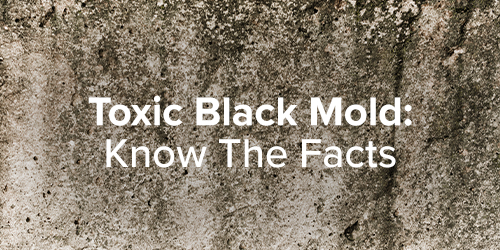There is a good chance that you have heard about the dangers of black mold, but did you know that this specific type of fungus is comprised of several different mold species that appear dark green and/or black? The most common “black mold” is Stachybotrys chartarum, and this what most people are referring to when black mold is being referenced. As an IICRC-certified mold removal and remediation company, The Jones Companies has seen our fair share of mold which is why we want to give you the facts about black mold.
Is Black Mold Dangerous?
Believe it or not, the shade of mold does not correlate to how dangerous it is, but there are molds that are toxic. When it comes to black mold, Stachybotrys chartarum, mycotoxins are produced which makes this species of mold toxigenic. Mycotoxins are toxic compounds that are naturally produced by certain types of molds (fungi).
Mycotoxins naturally occur and can cause negative health effects to people. Some individuals can be highly sensitive to black mold and exposure to it can cause wheezing, a runny or stuffy nose, itchy eyes, skin rashes, fever, and asthmatic reactions. The Institute of Medicine (IOM) has linked exposure to mold and upper respiratory tract symptoms in seemingly healthy individuals, and asthma and hypersensitivity pneumonitis to those who are immunocompromised. In 2009, the World Health Organization took this a step further and suggested a link between mold, housing conditions and the development of asthma in children.
How Common is Black Mold?
Unless you live within a sterile vacuum-like environment, the truth is you are surrounded by mold daily. Mold is everywhere, and we breath in the spores regularly. There are many species of black mold, making it fairly common. However, with regards to Stachybotrys chartarum, the prevalence is pretty low compared to other molds. We would like to note that toxic black mold rarely forms in isolation, and normally grows in conjunction with other types of mold.
What Does Black Mold Look Like?
If you are wondering what black mold looks like, keep these few tell-tale signs of black mold in mind.
Mold must have a moisture source to grow. So, if you see peeling paint or water stains, there is a chance that black mold could be growing behind the wall. If you notice visible signs of mold growing, pay attention to its appearance. Black mold will generally appear black in color; however, it can also be a dark green or grey hue color. The spores will be dampened downwards and be slimy.
Although moisture and mold go hand in hand, it is possible for the water source to run dry. If this is the case, the black mold may appear dry and powdery. If these black mold symptoms are present, sniff the air as a musty odor is a sure sign you may have a mold issue that requires a professional mold removal and mold remediation company.
Our Recommendation – Treat All Mold the Same
If you believe you have toxic black mold, or any mold for that matter, in your property, we say treat it all the same. Mold can cause severe allergic reactions that can cause damage your health. Your best option is to seek professional mold removal and mold remediation services from a trusted company to ensure your well-being. If you have any questions, the team at The Jones Companies is always happy to answer your questions about mold concerns.

